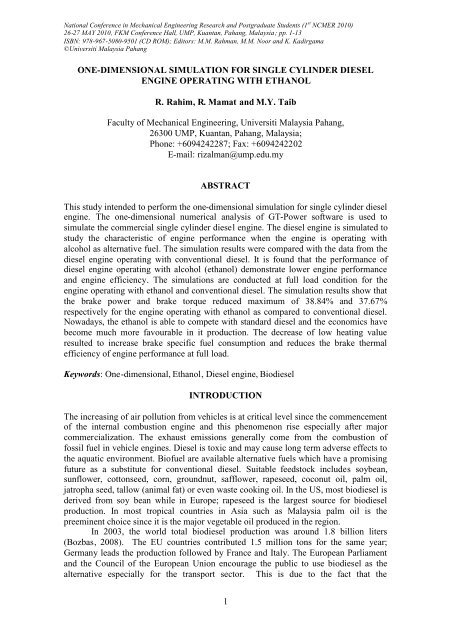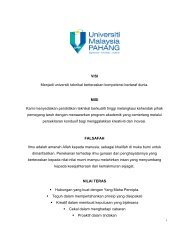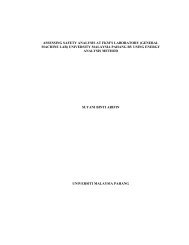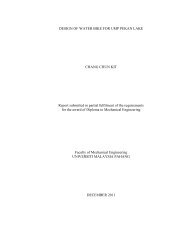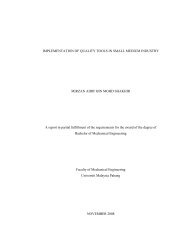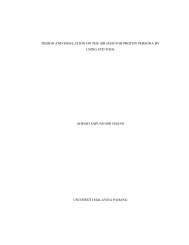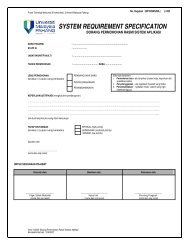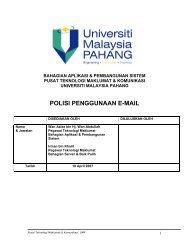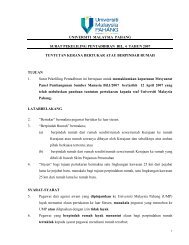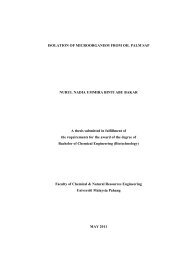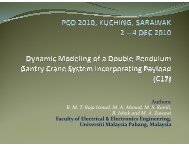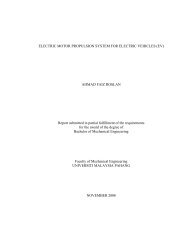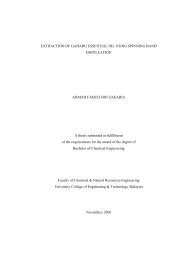1 ONE-DIMENSIONAL SIMULATION FOR SINGLE CYLINDER ...
1 ONE-DIMENSIONAL SIMULATION FOR SINGLE CYLINDER ...
1 ONE-DIMENSIONAL SIMULATION FOR SINGLE CYLINDER ...
Create successful ePaper yourself
Turn your PDF publications into a flip-book with our unique Google optimized e-Paper software.
National Conference in Mechanical Engineering Research and Postgraduate Students (1 st NCMER 2010)26-27 MAY 2010, FKM Conference Hall, UMP, Kuantan, Pahang, Malaysia; pp. 1-13ISBN: 978-967-5080-9501 (CD ROM); Editors: M.M. Rahman, M.M. Noor and K. Kadirgama©Universiti Malaysia Pahang<strong>ONE</strong>-<strong>DIMENSIONAL</strong> <strong>SIMULATION</strong> <strong>FOR</strong> <strong>SINGLE</strong> <strong>CYLINDER</strong> DIESELENGINE OPERATING WITH ETHANOLR. Rahim, R. Mamat and M.Y. TaibFaculty of Mechanical Engineering, Universiti Malaysia Pahang,26300 UMP, Kuantan, Pahang, Malaysia;Phone: +6094242287; Fax: +6094242202E-mail: rizalman@ump.edu.myABSTRACTThis study intended to perform the one-dimensional simulation for single cylinder dieselengine. The one-dimensional numerical analysis of GT-Power software is used tosimulate the commercial single cylinder diesel engine. The diesel engine is simulated tostudy the characteristic of engine performance when the engine is operating withalcohol as alternative fuel. The simulation results were compared with the data from thediesel engine operating with conventional diesel. It is found that the performance ofdiesel engine operating with alcohol (ethanol) demonstrate lower engine performanceand engine efficiency. The simulations are conducted at full load condition for theengine operating with ethanol and conventional diesel. The simulation results show thatthe brake power and brake torque reduced maximum of 38.84% and 37.67%respectively for the engine operating with ethanol as compared to conventional diesel.Nowadays, the ethanol is able to compete with standard diesel and the economics havebecome much more favourable in it production. The decrease of low heating valueresulted to increase brake specific fuel consumption and reduces the brake thermalefficiency of engine performance at full load.Keywords: One-dimensional, Ethanol, Diesel engine, BiodieselINTRODUCTIONThe increasing of air pollution from vehicles is at critical level since the commencementof the internal combustion engine and this phenomenon rise especially after majorcommercialization. The exhaust emissions generally come from the combustion offossil fuel in vehicle engines. Diesel is toxic and may cause long term adverse effects tothe aquatic environment. Biofuel are available alternative fuels which have a promisingfuture as a substitute for conventional diesel. Suitable feedstock includes soybean,sunflower, cottonseed, corn, groundnut, safflower, rapeseed, coconut oil, palm oil,jatropha seed, tallow (animal fat) or even waste cooking oil. In the US, most biodiesel isderived from soy bean while in Europe; rapeseed is the largest source for biodieselproduction. In most tropical countries in Asia such as Malaysia palm oil is thepreeminent choice since it is the major vegetable oil produced in the region.In 2003, the world total biodiesel production was around 1.8 billion liters(Bozbas, 2008). The EU countries contributed 1.5 million tons for the same year;Germany leads the production followed by France and Italy. The European Parliamentand the Council of the European Union encourage the public to use biodiesel as thealternative especially for the transport sector. This is due to the fact that the1
One-Dimensional Simulation for Single Cylinder Diesel Engine Operating With Ethanoltransportation sector accounted for 21% of all CO 2 emissions worldwide in 2002.Currently, 95% of all energy for the transportation sector comes from fossil fuel (Kreithand Goswami, 2007). The use of biofuel in the transport sector may not be just to reducethe emissions but also to shrink the dependence upon imported energy and influence thefuel market for transport and hence to secure the energy supply.The main benefit of biofuel is that it is ‘carbon neutral’. Although the enginesrunning on biofuel produce more CO 2 compare to conventional diesel fuels, if theanalysis includes the carbon cycle, the use of biofuel actually emit less CO2 toatmosphere(Mamat et al., 2008). The biodiesel could be used as it own or blended withconventional fossil fuel without having to make any modification to the standard dieselengines because biodiesel has comparable properties to diesel (Agarwal, 2007). A largeamount of research has been conducted on biofuel to perceive the performance and theimpact on emission levels to the environment. (Demirbas, 2007) suggested that thecombustion of biodiesel alone provides over a 90% reduction in total unburnedhydrocarbons (HC) and a 75-90% reduction in polycyclic aromatic hydrocarbons(PAHs). The results from previous experiments on biodiesel and their blends withmineral diesel in a single cylinder engine show that an increased proportion of biodieselblend resulted in higher NOx, reduced smoke and increased brake specific fuelconsumption (Chuepeng at al., 2007). The advantage of biodiesel was also reported bymany researchers as renewable energy, non-toxic, biodegradable and sulphur free(Labeckas and Slavinskas, 2006; Bozbas, 2008, Mamat et al., 2009). In addition, mixingof biodiesel with standard diesel fuel improves the lubricating properties of the fuel andreduced cylinder friction (Nwafor, 2004).Biofuel is normally characterized by its properties of density, viscosity, lowheating value, cetane number, cloud and pour points, characteristics of distillation, andflash and combustion points. Pure biodiesel or blends with mineral diesel may reducethe calorific value of the fuel thus may lead to reduced engine power and increased fuelconsumption (Rakopoulos et al., 2006). The cetane numbers of biodiesel and mineraldiesel are about the same but the volatility of biodiesel is slightly higher which mayaffect the ignition delay and increase the amount of fuel for rapid combustion and boostthe combustion temperature, thus producing higher NOx levels (Labeckas andSlavinskas, 2006). Some purpose such as water pumping for a single cylinder enginesare expansively used in agricultural area. The use of the diesel fuel and having only onecylinder make them an economic alternative due to their low investment cost andlimited fuel consumption. As a result, these engines are important auxiliary agriculturaltool for rural areas. In some cases these engines are also used for driving some vehicles(Bayrakceken et al., 2007). Alcohol maintains to get the global attention as alternativefuels despite of excess in crude oil. For a long period, as the world’s crude oil suppliesstop to meet worldwide consumption, it is likely that engines running on pure alcoholwill become more feasible. In the short term, particularly in those countries susceptibleto a shortage in crude oil supplies, contingency plans in the form of alternative liquidfuels to meet the needs of their transport and agricultural sectors are necessary.According to the extension of diesel fuel supplies, it is recently as a particular concern.The use of ethanol in compression – ignition engines has, therefore, receivedconsiderable attention with particular emphasis on adapting the fuel to meet therequirements of the engine (Ajav et al., 2000).Hansen et al. (1989) investigated the combustion of ethanol and blends ofethanol with diesel fuel with the support of a heat release model. They observed that theeffects of adding ethanol to diesel fuel were increased ignition delay, increased rates of2
R. Rahim, R. Mamat and M.Y. Taibpremixed combustion, increased thermal efficiency and reduced exhaust smoke.Czerwinski (1994) used a rapeseed oil, ethanol and diesel fuel blend and compared theheat release curves with diesel fuel. He observed that the addition of ethanol causedlonger ignition lag at all operating conditions. At higher and full loads, the combustionspeeds were high with strong premixed phases. Ali et al. (1996) operated a Cummins N14-410 engines on 12 fuels produced by blending methyl tallow ate, methyl soy ate andfuel ethanol with diesel fuel. The addition of ethanol to the fuel blends did not have aneffect on ignition delay. The charge temperature was reported to decrease with adecrease in the diesel content of the fuel blends. Table 1 shows the typical fuelproperties for diesel, ester and ethanol (Chen et al., 2008). The properties for these fuelsincludes boiling point, cloud point, oxygen content, carbon, hydrogen, viscosity,density, cetane number, flash point, heat value.Table 1: Properties of diesel fuel and ethanol(Rakopoulos et al., 2007)Fuel Properties Unit Diesel fuel EthanolDensity at 20°C kg/m 3 837 788Cetane number - 50 5-8Kinematic Viscosity at 40°C mm 2 /s 2.6 1.2Surface tension at 20°C N/m 0.023 0.015Lower Calorific Value MJ/kg 43 26.8Specific heat capacity J/kg. °C 1850 2100Boiling point °C 180-360 78Oxygen %weight 0 34.8Latent heat of evaporation kJ/kg 250 840Bulk modulus of elasticity Bar 16 000 13 200Stoichiometric air-fuel ratio - 15.0 9.0Molecular weight kg 170 46MODEL SETUPIn general, a one dimensional (1D) simulation of an engine model consists of intakesystem, exhaust system, compressor and variable geometry turbocharger system (VGT),common rail fuel injection systems, exhaust gas recirculation systems, engine cylindersand valve train. The development of the single cylinder modeling in one-dimensionalsimulation for four-stroke direct-injection (DI) diesel engine was presented in thispaper. The details of the engine parameters used in this model are described in Table 2.Figure 1 shows the diesel engine modeling using GT-POWER software. In the selecteddiesel engine, the intake system its have a few component, size and different data. Thesystem was started from environment till the intake valve. All of the intake systemcomponents in the GT-POWER model are environment, intrunnerairfilter, air filter,intrunner, inport, intvalve. The components in this system need a few data to completethe data form and running the model. Engine cylinder and fuel injection system isfocused in engine cylinder performance were support diesel fuel from fuel injectionsystem, fresh air intake system and exhaust gas to exhaust system. The components, sizeand data must be record and inserted to the GT-POWER form. All of the enginecylinder and fuel injection system component are injector, cylinder and engine. Exhaustsystem is the last system in the diesel engine. The system was started from exhaust3
One-Dimensional Simulation for Single Cylinder Diesel Engine Operating With Ethanolvalve and finished in the environment. The GT-POWER components in the exhaustsystem are exhvalve, exhport, exhrunner, muffler, exhrunnerexit, and environment.Table 2: Detail parameter of a single cylinder diesel engineNo Description Value1 Fuel Diesel2 Engine Type Single cylinder3 Displacement 406.6 cc4 Piston pin offset 1 mm5 Number of Cylinder 16 Bore 86.0 mm7 Stroke 70 mm8 Connecting Rod Length 118.1 mm9 Compression Ratio 17.312 Maximum Intake Valve Open 7.095 mm13 Maximum Exhaust Valve Open 7.095 mm14 Intake Duration 252 CAD15 Exhaust Duration 291 CADFigure 1: GT POWER single-cylinder diesel engineThe diesel engine modeling using GTPOWER computational model consist ofthe intake system model, engine cylinder and fuel injection system model, and exhaustsystem model. The intake system, the engine cylinder and fuel injection system wereconnected in which the intvalve in the intake system and cylinder in the engine cylinderand fuel injection system. All of this diesel engine components connected byorifficeconn. If the work was finish its can developed the diesel engine modeling usingGTPOWER software as shown in Figure 1. The data is very important for building anengine model. A list of information that is required to build a model in GTPOWER isincluded in library. Not every item will be required for all models, and sometimesadditional information will be needed, but the list is generally a good starting point. Ifthe model is being built at an early design stage, determining optimal values for some ofthe items listed may be the purpose of the simulation. If this is the case, those particular4
R. Rahim, R. Mamat and M.Y. Taibattributes should be defined as parameters and run for a series of cases to determine anoptimal value. Data required in engine characteristics are compression ratio, firingorder, inline or V configuration, V-angle (optional), 2 or 4 stroke. Data required incylinder geometry are bore, stroke, connecting rod length, pin offset, piston TDCclearance height, head bowl geometry, piston area and head area. Data needed in intakeand exhaust system is geometry of all components. Data in throttles are throttle locationand discharge coefficients versus throttle angle in both flow directions. Data in fuelinjectors are location and number of injectors, number of nozzle holes and nozzlediameter, injection rate, fuel type and LHV. Data in intake and exhaust valves are valvediameter lift profile, discharge coefficient, valve lash. Data in ambient state arepressure, temperature and humidity. Performance data can be very useful when tuning amodel after it has been built. The preparation was important before the modelsimulation was running. The preparations are to review the completed model, run setup,case setup, plot requests and plot setup. All of the parameters in the model will be listedautomatically in the setup and each one must be defined for first case of the simulation.Commonly, computation time can be reduced in steady state simulations by planningthe order of the simulations and utilizing the initialization state in run setup. Cycleand/or time plots may be requested by selecting the appropriate plot from the plotoptions folder within each part. All plots requested in individual parts will be storedregardless of whether the user chooses to use plot setup. If the model has been preparedfor simulation, the GT-POWER simulation may be started and this will start thesimulation running. A window wills be progress of simulation in the form of scrollingtext. Once the input has been read successfully, the simulations will begin, andoccasional reports of the progress will be given.Engine Performance ParametersIn this section, some basic parameters that commonly used to characterize engineoperation are developed. These include the mechanical output parameters of work,torque, and power; the input requirement of air, fuel and combustion; efficiencies; andemission measurement of engine exhaust(Heywood, 1988, Pulkrabek, 2004).Volumetric Efficiency: Volumetric efficiency is used as an overall measure of theeffectiveness of a four stroke cycle engine and its intake and exhaust system as an airpumping device. The equation use for volumetric efficiency is expressed as Eq. (1)(Pulkrabek, 2004):ma (1)VN / 2where amVadisp= the inlet air density.adisp= the steady-state flow of air into the engine= displacement volumeBrake Engine Torque: Torque is a good indicator of an engine’s ability to do work. Itis defined as force acting at a moment distance and has units of N-m or lbf-ft. Torque (τ)is related to work by Pulkrabek (2004):2 W( bmep)V n(2)b d /5
One-Dimensional Simulation for Single Cylinder Diesel Engine Operating With EthanolwhereW b = brake work of one revolutionV d = displacement volumen = number of revolutions per cycleFor a four-stroke cycle engine that takes two revolutions per cycle, bmep)V / 4(3)(dBrake Power: Power is defined as the rate of work of the engine. If n = number ofrevolutions per cycle and N = engine speed, then brake power is expressed as Eq. (4)Pulkrabek (2004):where W = work per cycleA = piston face area of all pistonspU p= average piston speedWWN/ nW2N W (1/ 2 n )( mep ) A p U pW mep)A p U / 4(4)( pBrake Thermal Efficiency: Brake thermal efficiency ( bth ) is the ratio of energy in thebrake power, (bp), to the input fuel energy in appropriate units (Ganesan, 2003).Solving for thermal efficiency as per below:bthbpMass of fuelscalorificvalue of fuel (5)Brake Mean Effective Pressure: Mean effective pressure is a good parameter forcomparing engines with regard to design or output because it is independent of bothengine size and speed. If brake work is used, brake mean effective pressure is obtained:bmep wb / vwherevv bdc vtdcbmep 2 n/Brake Specific Fuel Consumption: Brake power gives the brake specific fuelconsumption:V dwherem f = rate of fuel flow into enginebsfc m f / Wb(6)6
R. Rahim, R. Mamat and M.Y. TaibRESULTS AND DISCUSSIONIn this study, the effects of ethanol and diesel fuel on the engine performance werebeing discussed. The tests were performed by varying the engine speed starting from500 rpm until 4000 rpm with the increment of 500 rpm. The variation of the engineperformance that had been discussed were engine air flow, volumetric efficiency, brakepower, brake thermal efficiency, brake engine torque, brake mean effective pressure,brake specific fuel consumption and in-cylinder pressure. The results from thesimulation model were compared the trends between the diesel and ethanol fuel.Figure 2 shows the effect of engine air flow with respect to engine speed. It can be seenthat the trend for this fuel were similar for diesel fuel and ethanol. The engine air flowincrease as increasing of the engine speed. The stoichiometric air-fuel ratio (AFR) forethanol is 40% lower than diesel fuel. Therefore, the engine air flow operating withethanol is slightly lower due to inducted less air as compared to diesel fuel.Engine air flow [kg/h]50403020100500 1000 1500 2000 2500 3000 3500 4000Engine speed [rpm]DieselEthanolFigure 2: Effect of engine speed variation on engine air flowFigure 3 shows the effect of volumetric efficiency with respect to engine speed.It can be seen that the maximum efficiency achieved at 2000rpm of engine speed.Engine with higher volumetric efficiency will generally be able to run at higher speedsand produce more overall power due to less parasitic power loss moving air in and outof the engine. The turning point for the volumetric efficiency occurs at the engine speed2500rpm, so volumetric efficiency decrease sharply as the engine speed increasefurther. The sharp decrease happens because of higher speed is accompanied by somephenomenon that have negative influence on . These phenomenon’s include thecharge heating in the manifold and higher friction flow losses which increase as thesquare of engine speed.(Rahman et al., 2009)7
One-Dimensional Simulation for Single Cylinder Diesel Engine Operating With EthanolVolumetric Efficiency [%]0.90.850.80.750.70.650.6500 1000 1500 2000 2500 3000 3500 4000Engine Speed [rpm]DieselEthanolFigure 3: Variation of volumetric efficiency against engine speedThe variation of brake power for diesel and ethanol with engine speed is shownin Figure 4. The figure illustrates the engine outputs at full load. It was observed that theinjection delay of diesel fuel was longer than that of ethanol and the ignition delaydecreases with the increase in brake power. A close resemblance occurred at low speedrepresenting small discrepancy in output between the fuels. However, at higher speed, aclear gap appeared between the diesel fuel and ethanol. The maximum brake power fordiesel and ethanol are 6.86 kW and 4.20 kW respectively. The maximum reductionbrake power recorded was about 38.84% at the highest speed. It is well known that theheating value of the fuel affects the power of an engine. The lower energy level of theethanol fuel causes some reductions in the engine power when it is used in dieselengines without any modifications (Ozer et al., 2004).Brake Power [kW]876543210500 1000 1500 2000 2500 3000 3500 4000Engine Speed [rpm]8DieselEthanolFigure 4: Variation of brake power for diesel and ethanol with engine speedFigure 5 shows the variation of brake thermal efficiency with engine speed. It isa good measure in assessing how efficiently the energy in the fuel was converted tomechanical output. They generally show similar trends and closely resemble oneanother. The brake thermal efficiencies for ethanol were lower compared to diesel fuel.The maximum reductions were about 1.2% and 0.9% for the engine speed 1500rpm and
R. Rahim, R. Mamat and M.Y. Taib2000rpm, respectively. Brake thermal efficiency lower for ethanol due to lower calorificvalue compared to diesel fuel. Increasing the ethanol amount in the fuel blend decreasedthe brake thermal efficiency.(Rakopoulos et al., 2008)Brake Thermal EngineEfficiency [%]4035302520151050500 1000 1500 2000 2500 3000 3500 4000Engine Speed [rpm]DieselEthanolFigure 5: Effect of engine speed variation on brake thermal efficiencyThe effect of diesel fuel and ethanol on brake engine torque for various speeds isshown in Figure 6. The torque is a function of engine speed (Abu-Zaid, 2004). At lowspeed, torque increases as the engine speed increase, reaches a maximum and then, asengine speed increase further, torque decreases as shown in Figure 6. The torquedecreases because the engine is unable to ingest a full charge of air at the higher speed.From Figure 6, it is clearly shown the gap between diesel fuel and ethanol. Themaximum reduction brake engine torque recorded was about 37.67% when enginespeed achieved at 2000 rpm.25Brake Engine Torque [N.m]20151050500 1000 1500 2000 2500 3000 3500 4000DieselEthanolEngine Speed [rpm]Figure 6: Variation of brake engine torque against engine speedFigure 7 shows the variation of brake mean effective pressure against enginespeed. They generally show the similar trends for both fuels. The maximum reductionof the brake mean effective pressure recorded was about the same with the brake enginetorque.9
One-Dimensional Simulation for Single Cylinder Diesel Engine Operating With EthanolBrake Mean Effective Pressure [bar]876543210500 1000 1500 2000 2500 3000 3500 4000DieselEthanolEngine Speed [rpm]Figure 7: Variation of brake mean effective Pressure against engine speedFigure 8 shows the effect of engine speed variation on brake specific fuelconsumption (BSFC) for diesel fuel and ethanol. They generally show similar trends forboth fuels. The minimum BSFC (241.484 g/kWhr) was obtained for diesel, (388.882)g/kWhr for ethanol. As shown in Table 1, the cetane number for diesel fuel is highestthan ethanol. Table 1 shows that the diesel fuel has the higher low calorific value (43MJ/kg) compared to ethanol (26.8 MJ/kg). From Figure 8 and Table 1, it was observedthat the higher BSFC for ethanol was due to longer ignition delay. It is caused by theirlower cetane number. The decreasing of the cetane number, increase the ignition delay.Increasing the ethanol amount in the fuel blend increased the brake specific fuelconsumption (Rakopoulos et al., 2008).Brake Specific FuelConsumption [g/kWhr]8007006005004003002001000500 1000 1500 2000 2500 3000 3500 4000DieselEthanolEngine Speed [rpm]Figure 8: Effect of engine speed variation on brake specific fuel consumptionFigure 9 shows the effect of engine speed variation on in-cylinder pressure fordiesel fuel and ethanol. The results show that the peak pressure for diesel is highercompared with ethanol. It is found that the ignition delay for diesel is lower due tohighest cetane number, resulting in high peak in-cylinder pressure. The graph line ofpressure rise and drop suggest that the shorter ignition delay occurs and it thusresponsible for the early start of combustion with the engine operating. If combustionstarts too early in the cycle, the work transfer from the piston to the gases in the cylinderat the end of the compression is too large. If the combustion starts too late, the peak10
R. Rahim, R. Mamat and M.Y. Taibcylinder pressure is reduced, and the expansion stroke work transfer from the gas to thepiston decreases (Alla, 2002).In-Cylinder Pressure [bar]1000900800700600500400Diesel300Ethanol2001000-137 -63 11 85 159CADFigure 9: Effect of CAD variation on In-Cylinder PressureCONCLUSIONThe effect of using the different fuels and their impact on the engine performance of asingle cylinder diesel engine has been investigated and the conclusions can besummarized as follows:1. The decrease in brake thermal efficiency because of the lower low heating value.Among the two fuels of ethanol and diesel, the lower brake thermal efficiencywas obtained from ethanol.2. The brake specific fuel consumption increased mainly due to the lower lowheating value. The brake specific fuel consumption for ethanol was higher thanthat of diesel fuel.3. It is found that the ignition delay for ethanol was increased due to the lowercetane number, thus resulting in low peak in-cylinder pressure.4. The lower energy content of ethanol caused some increment in brake specificfuel consumption of the engine depending on the percentage of ethanol in blend.ACKNOWLEDGEMENTThe authors would like to acknowledge to University Malaysia Pahang for the financialsupport.REFERENCESAbu-zaid, M. 2004. Performance of single cylinder, direct injection Diesel engine usingwater fuel emulsions. Energy Conversion & Management, 45: 697-705.Agarwal, A.K. 2007. Biofuels (Alcohol and Biodiesel) Applications as fuels forinternal combustion engines. Progress in Energy and Combustion Science, 33:233-271.11
One-Dimensional Simulation for Single Cylinder Diesel Engine Operating With EthanolAli, Y., Hanna, M.A. and Borg, J.E. 1996. Effect of alternative diesel fuels on heatrelease curves for cummins N14-410 diesel engine. Transaction of ASAE, 39:407-14.Alla, G.H.A. 2002. Computer simulation of a four stroke spark ignition engine. EnergyConversion & Management, 43: 1043-1061.Bayrakceken, H., Tasgetiren, S. and Aksoy, F. 2007. Failures of single cylinder dieselengine crankshaft. Engineering Failure Analysis, 14: 725-730.Bozbas, K. 2008. Biodiesel as an alternative motor fuel: production and policies in theeuropean union. Renewable and Sustainable Energy Reviews, 12: 542-552.Chen, H., Wang, J., Shuai, S. and Chen, W. 2008. Study of oxygenated biomass fuelblends on a diesel engine. Fuel 87: 3462–3468.Chuepeng, S. and AL., E. 2007. A Study of quantitative impact on emissions of highproportion rme-based biodiesel blends. SAE Technical Paper, No. 2007-01-0072.Czerwinski, J. 1994. Performance of HD-DI diesel engine with addition of ethanol andrapeseed oil. Warrendale: Soc of Automotive Engineers. , Paper No. 1994-0545.Demirbas, A. 2007. Importance of biodiesel as transportation fuel. Energy Policy, 35:4661.Ajav, E.A., Singh, B. and Bhattacharya, T.K. 2000. Thermal balance of a single cylinderdiesel engine operating on alternative fuels .Energy Conversion & Management,41: 1533-1541.Ganesan, V. 2003. Internal combustion engines. New Delhi: Tata McGraw HillCompany Limited.Hansen, A.C., Taylor, P.W., Lyne, L. and Meiring, P. 1989. Heat release in thecompression-ignition combustion of ethanol. Transaction of ASAE, 32: 1507-11.Heywood, J.B. 1988. Internal combustion engine fundamentals. New York: McGraw-HillKreith, F. and Goswami, D.Y. 2007. Handbook of energy efficiency and renewableenergy. London: CRC Press.Labeckas, G. and Slavinskas, S. 2006. The Effect of rapeseed oil methyl ester on directinjection diesel engine performance and exhaust emissions. Energy Conversionand Management, 47: 1954-1967.Mamat, R., Abdullah, N.R., Xu, H., WyszynskI, M.L. and Tsolakis, A. 2009. Effect offuel temperature on performance and emissions of a common rail diesel engineoperating with Rapeseed Methyl Ester (RME). SAE International, 01: 1896-??.Mamat, R., Cheupeng, S., Xu, H. and Wyszynski, M.L. 2008. Effect of exhaust gastemperature on engine performance and emissions of a conventional V6 dieselengine operating on biodiesel & diesel fuel with exhaust gas recirculation(EGR). United Kingdom-Malaysia Engineering Congress London.Nwafor, O.M.I. 2004. Emission characteristics of diesel engine operating on RapeseedMethyl Ester. Renewable Energy, 29: 119-129.Ozer, C., Ismet, C. Eelikten B & C, N. U. 2004. Effects of ethanol addition onperformance and emissions of a turbocharged indirect injection Diesel enginerunning at different injection pressures. Energy Conversion & Management, 45,2429-2440.Pulkrabek, W.W. 2004. Engineering fundamentals of the internal combustion engine.New York: Pearson-Prentice Hall.12
R. Rahim, R. Mamat and M.Y. TaibRahman, M.M., Mohammed, M.K. and Bakar, R.A. 2009. Effects of air fuel ratio andengine speed on engine performance of hydrogen fueled port injection engine.American Journal of Scientific Research, 1: 23-33.Rakopoulos, C.D. and AL., E. 2006. Comparative performance and emissions study of adirect injection diesel engine using blends of diesel fuel with vegetable oils orbio-diesels of various origins. Energy Conversion and Management, 47: 3272-3287.Rakopoulos, C.D., Antonopoulos, K.A. and Rakopoulos, D.C. 2007. Experimental heatrelease analysis and emissions of a HSDI diesel engine fueled with ethanol–diesel fuel blends. Energy, 32: 1791-1808.Rakopoulos, D., Rakopoulos, C., Kakaras, E. and Giakoumis, E. 2008. Effect ofethanol–diesel fuel blends on the engine performance and emissions of heavyduty DI diesel engine. Energy Conversion & Management, 49: 3155-3162.13


